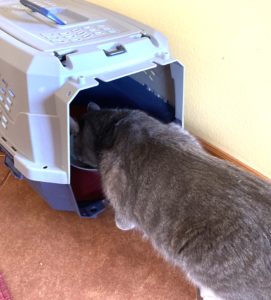Carrier Training Your Cat
Cats tend to be homebodies. Most are not very fond of traveling. However, with some training and attention to their needs, trips to the vet and even cross-country do not need to be a traumatic experience.
Choosing A Carrier for Your Cat
There are lots of options out there. The traditional plastic box works well; it is secure and easy to clean. Make sure the top is easily removable – some carriers have more bolts (9+) than necessary. If you have one of these, you can often remove about 1/3 of the bolts even if your cat is heavy.
There are more and more styles of fabric carriers – if you are looking for one, choose one that has side panels that open up, or a top that zips open. Think: How will you get your cat out of the carrier? How will you get him back in (if he is reluctant)?
Make sure the carrier is big enough. Cats are masters at squeezing themselves into small spaces but the carrier needs to be comfortable in case your cat must stay in it for a bit. Your cat should be able to stand up and turn around in her carrier.
Method #1- Feeding in the Carrier
Using method #1 for carrier training your cat, you will feed your cat in his carrier.
Place your cat’s food bowl near his carrier. Over the next few days to a week, you will move the food closer to the carrier, then put it just inside the carrier, then finally put it in the back of the carrier.
Gus was trapped as a feral cat. He was reluctant to enter the carrier, so we removed the lid for him.
Once Gus was comfortable eating in the bottom of his carrier, we placed the top on the carrier without the gate.
Once he was willing to eat in the carrier with the top on, we introduced the gate.
First, we had him eat with the gate open; the next step was to close the gate for a minute. Some food on the gate helped him stay calm for this.



Method #2 – Using Targeting
Carrier training your cat using method #2 is based on a clicker training technique called targeting.
- you start by luring your cat to the back of bottom half of her carrier using the target stick.
- once she will sit in the bottom half of the carrier calmly, place the top on the carrier. Have her enter following the target stick and then sit.
- work up to having her stay for the count of 5
- once she is calm with this, close the door and have her stay for the count of 5
Extra Credit:
Once your cat is comfortable in her carrier, lure her in with a snack or target stick, close the door and move her to another room. Upon arriving in the other room, open the door and reward her with a snack!
Make sure to take your time. Cats are individuals and some learn faster than others. You may need to break up the training into smaller steps if your cat is reluctant to enter the carrier. Gus, a former feral cat, is leery of things that may be traps – it took longer for him to accept the carrier than Zelda, who appears in the video above.

